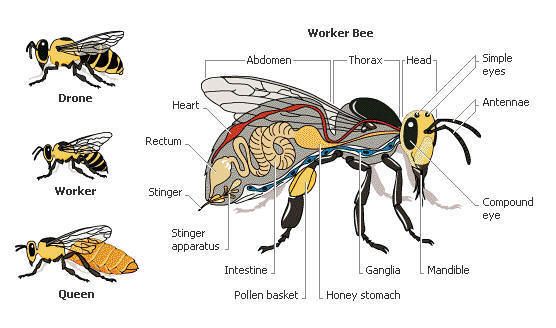Neat Facts About Bees
Another miracle discovered recently and mentioned in Quran
BEES HAVE 2 STOMACHES
{وَأَوْحَىٰ رَبُّكَ إِلَى النَّحْلِ أَنِ اتَّخِذِي مِنَ الْجِبَالِ بُيُوتًا وَمِنَ الشَّجَرِ وَمِمَّا يَعْرِشُونَ (68) ثُمَّ كُلِي مِن كُلِّ الثَّمَرَاتِ فَاسْلُكِي سُبُلَ رَبِّكِ ذُلُلًا ۚ يَخْرُجُ مِن بُطُونِهَا شَرَابٌ مُّخْتَلِفٌ أَلْوَانُهُ فِيهِ شِفَاءٌ لِّلنَّاسِ ۗ إِنَّ فِي ذَٰلِكَ لَآيَةً لِّقَوْمٍ يَتَفَكَّرُونَ (69)} [النحل : 68-69]
Quran 16:68-69
( 68 ) And your Lord inspired to the bee, "Take for yourself among the mountains, houses, and among the trees and [in] that which they construct.
( 69 ) Then eat from all the fruits and follow the ways of your Lord laid down [for you]." There emerges from their "BELLIES" a drink, varying in colors, in which there is healing for people. Indeed in that is a sign for a people who give thought.
There are three kinds of bees in a hive: Queen, Worker and Drone.
Only the Queen in the hive lays eggs. She communicates with her hive with her own special scent called pheromones. The queen will lay around 1,500 eggs per day.
The worker bees are all female and they do all the work for the hive. Workers perform the following tasks inside the hive as a House Bee: Cleaning, feeding the baby bees, feeding and taking care of the queen, packing pollen and nectar into cells, capping cells, building and repairing honeycombs, fanning to cool the hive and guarding the hive.
Workers perform the following tasks outside the hive as Field Bees: Gathering nectar and pollen from flowers, collecting water and a sticky substance called propolis.
Bees have two stomachs - one stomach for eating and the other special stomach is for storing nectar collected from flowers or water so that they can carry it back to their hive.
The male bees in the hive are called drones. Their job in the hive is to find a queen to mate with. Male bees fly out and meet in special drone congregation areas where they hope to meet a queen. Male drone bees don't have a stinger.
If a worker bee uses her stinger, she will die.
Bees are classified as insects and they have six legs.
Bees have five eyes - two compound eyes and three tiny ocelli eyes.
Bees go through four stages of development: Egg, Larvae, Pupae and Adult Bee.
The bees use their honeycomb cells to raise their babies in, and to store nectar, honey, pollen and water.
Nectar is a sweet watery substance that the bees gather. After they process the nectar in their stomach they regurgitate it into the honeycomb cells. Then they fan with their wings to remove excess moisture. The final result is honey.
Bees are the only insect in the world that make food that humans can eat.
Honey has natural preservatives and bacteria can't grow in it.
Honey was found in the tombs in Egypt and it was still edible! Bees have been here for around 30 million years.
A honeybee can fly 24 km in an hour at a speed of 15 mph. Its wings beat 200 times per second or 12,000 beats per minute.
Bees have straw-like tongues called proboscis so they can suck up liquids and also mandibles so they can chew.
Bees carry pollen on their hind legs called a pollen basket. Pollen is a source of protein for the hive and is needed to feed the baby bees to help them grow.
A beehive in summer can have as many as 50,000 to 80,000 bees. A bee must collect nectar from about 2 million flowers to make 1 pound of honey. It requires 556 worker bees to gather a pound of honey. Bees fly more than once around the world to gather a pound of honey.
The average worker bee makes about 1/12th of a teaspoon of honey in her lifetime.
Bees have 2 pairs of wings. The wings have tiny teeth so they can lock together when the bee is flying.
Bees communicate through chemical scents called pheromones and through special bee dances.
Every 3rd mouthful of food is produced by bees pollinating crops. Flowering plants rely on bees for pollination so that they can produce fruit and seeds. Without bees pollinating these plants, there would not be very many fruits or vegetables to eat.
A single beehive can make more than 100 pounds (45 kg) of extra honey. The beekeeper only harvests the extra honey made by the bees.
The average life of a honey bee during the working season is about three to six weeks. There are five products that come from the hive: honey, beeswax, pollen, propolis, and royal jelly.
Beeswax is produced by the bees. Bees have special glands on their stomach that secrete the wax into little wax pockets on their stomach. The bee takes the wax and chews it with her mandibles and shapes it to make a honeycomb.
Propolis is a sticky substance that bees collect from the buds of trees. Bees use propolis to weatherproof their hive against drafts or in spots where rain might leak in.
People have discovered the anti-bacterial properties of propolis for use in the medical field.
Royal Jelly is a milky substance produced in a special gland in the worker bee's head. For her whole life, the Queen is fed Royal Jelly by the workers.
Although bears do like honey, they prefer to eat the bee larvae.
Honey comes in different colours and flavours. The flower which the nectar was gathered from determines the flavour and colour of the honey.
